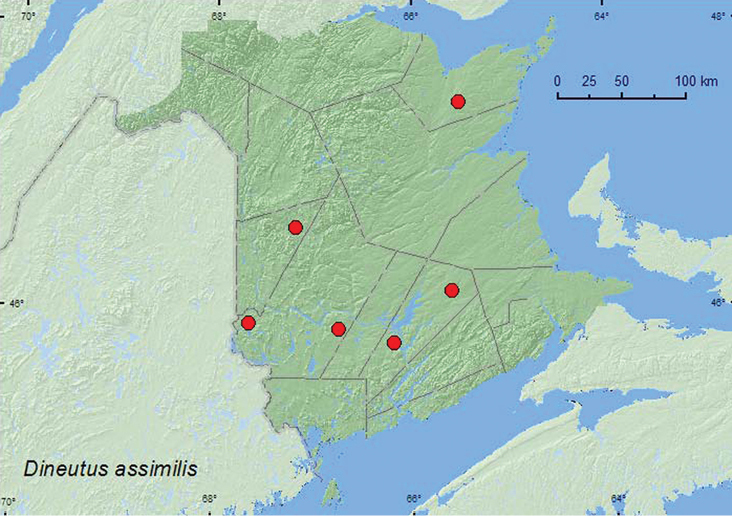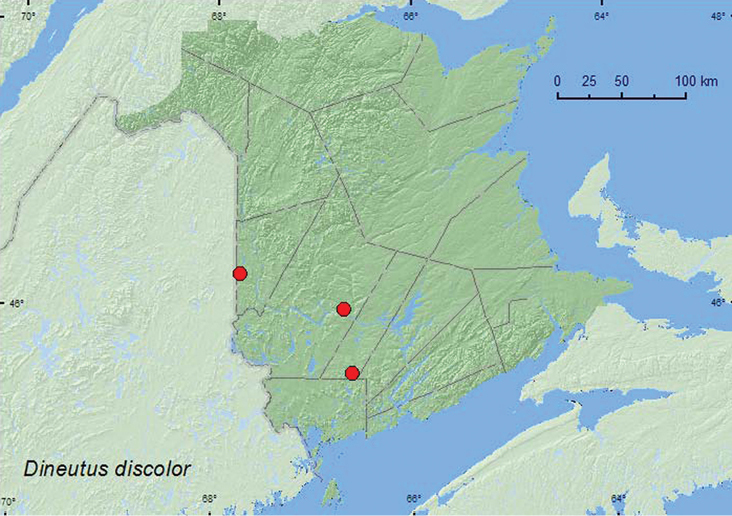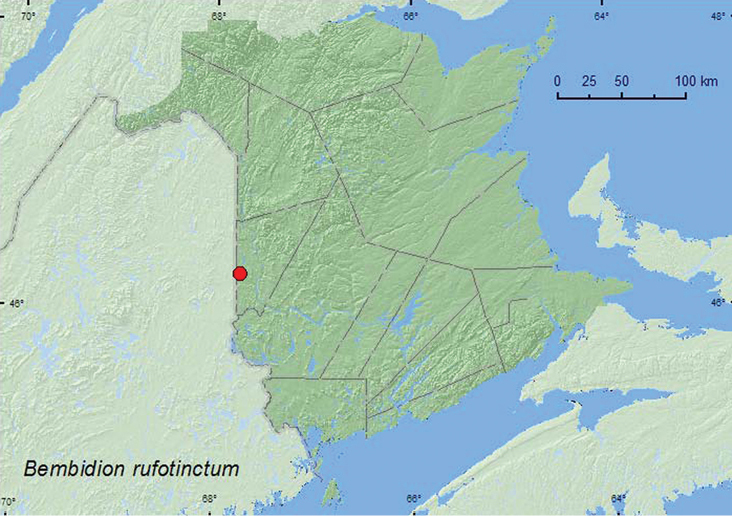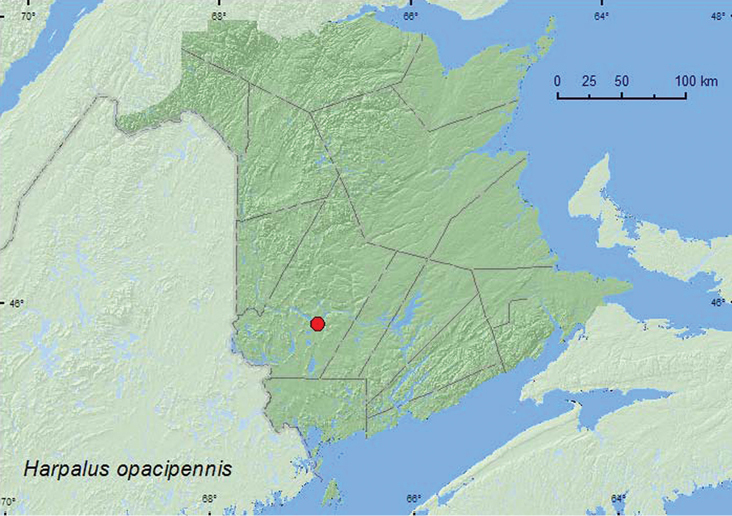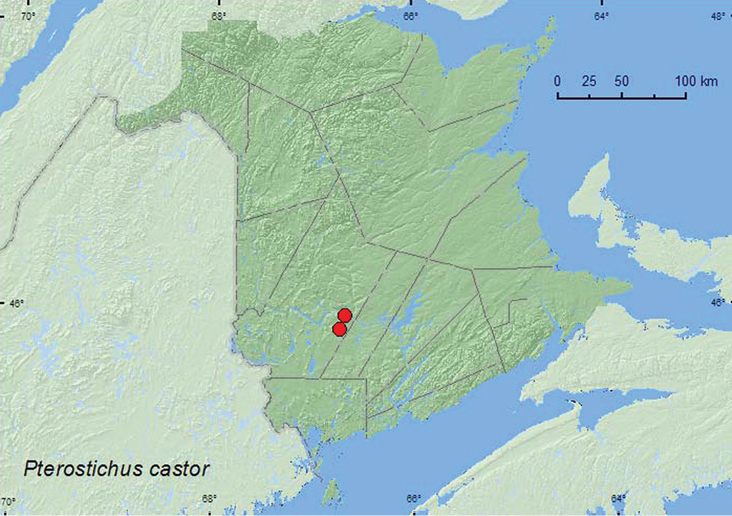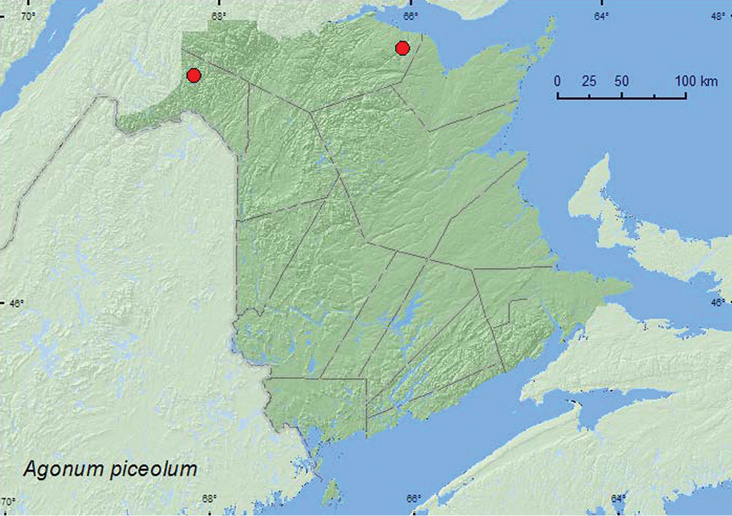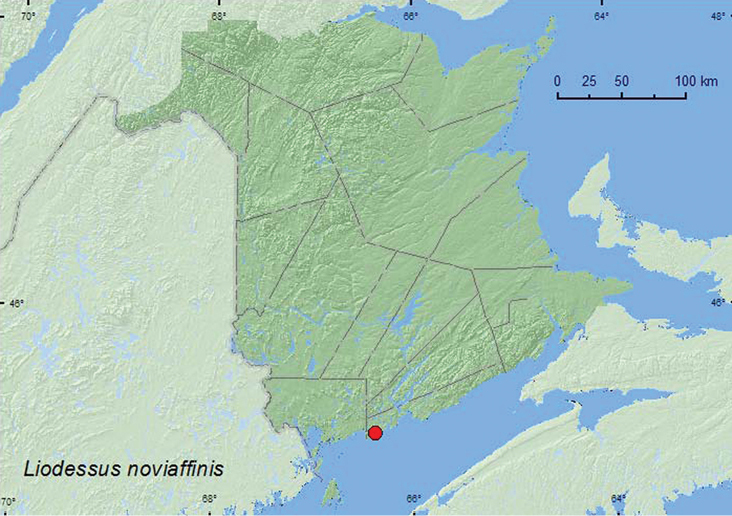






(C) 2012 Reginald P. Webster. This is an open access article distributed under the terms of the Creative Commons Attribution License 3.0 (CC-BY), which permits unrestricted use, distribution, and reproduction in any medium, provided the original author and source are credited.
For reference, use of the paginated PDF or printed version of this article is recommended.
Dineutus assimilis Kirby and Dineutus discolor Aubé of the Family Gyrinidae are newly reported from New Brunswick, Canada. Four species of Carabidae, Agonum (Agonum) piceolum (LeConte), Bembidion (Pseudoperyphus) rufotinctum Chaudoir, Harpalus (Harpalus) opacipennis (Haldeman), and Pterostichus (Melanius) castor Goulet & Bousquet are newly reported from New Brunswick and the Maritime provinces, and one species of Dytiscidae, Liodessus noviaffinis Miller, is newly recorded for the province. Collection, habitat data, and distribution maps are presented for each species.
Gyrinidae, Carabidae, Dytiscidae, new records, Canada, New Brunswick
This paper treats new species records from New Brunswick, Canada of the Coleoptera families Gyrinidae, Carabidae, and Dytiscidae. The fauna of these families from New Brunswick and the Maritime provinces was recently treated by
The following records are based on specimens collected during a general survey by the first author to document the Coleoptera fauna of New Brunswick.
Collection methodsVarious methods were employed to collect the specimens reported in this study, and these are included in the bionomic notes accompanying each species. A description of the habitat was recorded for all specimens collected during this survey. Locality and habitat data are presented exactly as on labels for each record. This information is summarized and discussed in collection and habitat data section for each species.
Specimen preparationMales of some species were dissected to confirm their identity. The genital structures were dehydrated in absolute alcohol and either mounted in Canada balsam on celluloid microslides or glued onto cards and then pinned with the specimens from which they originated.
DistributionDistribution maps, created using ArcMap and ArcGIS, are presented for each species in New Brunswick. Every species is cited with current distribution in Canada and Alaska, using abbreviations for the state, provinces, and territories. New records for New Brunswick are indicated in bold under Distribution in Canada and Alaska. The following abbreviations are used in the text:
| AK | Alaska | MB | Manitoba |
| YT | Yukon Territory | ON | Ontario |
| NT | Northwest Territories | QC | Quebec |
| NU | Nunavut | NB | New Brunswick |
| BC | British Columbia | PE | Prince Edward Island |
| AB | Alberta | NS | Nova Scotia |
| SK | Saskatchewan | NF & LB | Newfoundland and Labrador* |
*Newfoundland and Labrador are each treated separately under the current Distribution in Canada and Alaska.
Acronyms of collections examined or where specimens reside referred to in this study are as follows:
AFC Atlantic Forestry Centre, Natural Resources Canada, Canadian Forest Service, Fredericton, New Brunswick, Canada
CNC Canadian National Collection of Insects, Arachnids and Nematodes, Agriculture and Agri-Food Canada, Ottawa, Ontario, Canada
NBM New Brunswick Museum, Saint John, New Brunswick, Canada
RWC Reginald P. Webster Collection, Charters Settlement, New Brunswick, Canada
Results Species accountsAll records below are species newly recorded for New Brunswick, Canada. Species followed by ** are newly recorded from the Maritime provinces of Canada.
Family Gyrinidae Latreille, 1810A general overview of the Gyrinidae (the whirligig beetles) of North America was provided by
New Brunswick, Carleton Co., Juniper Station in the Juniper Barren, 46.5538°N, 67.1840°W, 21.VI.2005, R. P. Webster, black spruce / tamarack bog, margin of pond (2, RWC). Gloucester Co., off Hwy 8 near Allardville, 47.4303°N, 65.5163°W, 25.VI.2005, R. P. Webster, black spruce bog, on margin of small shallow pond with emergent grasses (1, RWC). Queens Co., ca. 3.5 km W of Lower Gagetown, 45.7497°N, 66.1846°W, 13.V.2008, R. P. Webster, old red oak and red maple forest, in small pond (1, RWC); Cranberry Lake P.N.A. [Protected Natural Area], 46.1125°N, 65.6075°W, 28.VII.2009, R. Webster & M.-A. Giguère, old red oak forest, u.v. light (1, AFC). York Co., Canterbury, Browns Mtn. Fen complex, 45.8841°N, 67.6428°W, 8.VI.2004, D. Sabine & R. Webster, sedge marsh in small pond (1, RWC); Charters Settlement, 45.8395°N, 66.7391°W, 23.VII.2007, R. P. Webster, mixed forest, u.v. light (1, RWC).
Collection localities in New Brunswick, Canada of Dineutus assimilis.
In New Brunswick, Dineutus assimilis was collected along pond margins with scattered emergent vegetation in black spruce (Picea mariana (Mill.) BSP) and tamarack (Larix laricina (Du Roi) Koch.) bogs, in a small pond in a Carex marsh, and in a small pond on the margin of a red oak (Quercus rubra L.) and red maple (Acer rubrum L.) forest. A few individuals were collected at ultraviolet light. Adults were captured during May, June, and July.
BC, AB, SK, MB, ON, QC, NB, PE (
New Brunswick, Carleton Co., Jackson Falls, 46.2257°N, 67.7437°W, 12.IX.2009, R. P. Webster (river margin) (1, RWC). Sunbury Co., Juvenile Settlement at S. Branch of Oromocto River, 45.5341°N, 66.6096°W, 27.VI.2006, M.-A. Giguère & R. Webster (4, RWC). York Co., Fredericton, Rt. 105 at Nashwaaksis River, 45.9850°N, 66.6900°W, R. P. Webster, 28.VI.2005, 6.V.2006, river margin in embayment with sand gravel bottom, sun-exposed (5, RWC).
Collection localities in New Brunswick, Canada of Dineutus discolor.
In Quebec, Dineutus discolor was usually found in clear, running water (Morrisette 1979). New Brunswick specimens were collected along river margins in embayments. Adults were collected during May, June, and September in New Brunswick.
ON, QC, NB, NS (
The Carabidae (the ground beetles) is a large family with 2, 635 species and subspecies in North America (
http://species-id.net/wiki/Bembidion_rufotinctum
Map 3New Brunswick, Carleton Co., Jackson Falls, 46.2257°N, 67.7437°W, 12.IX.2009, 22.V.2010, R. P. Webster, river margin above waterfall, on exposed bedrock (23, CNC, NBM, RWC).
Collection localities in New Brunswick, Canada of Bembidion rufotinctum.
Bembidion rufotinctum lives in cracks of emergent bedrock in river channels (
QC, NB (
http://species-id.net/wiki/Harpalus_opacipennis
Map 4New Brunswick, York Co., Queensbury, 12.VIII.1998, (G. Gesner & J. Sweeney) pitfall trap (2, AFC).
Collection localities in New Brunswick, Canada of Harpalus opacipennis.
There were no habitat data associated with the specimens. The site where adults were collected was a cone and seed orchard with dry meadow vegetation among trees. The two specimens were captured in a pitfall trap during August. This species is usually associated with dry habitats with sand or gravel soils with sparse vegetation, including gravel and sand pits, vacant fields, meadows, and clearings (
AK, YK, NT, BC, AB, SK, MB, ON, QC, NB (
http://species-id.net/wiki/Pterostichus_castor
Map 5New Brunswick, York Co., Fredericton, 45.9361°N, 66.6747°W, 17.VIII.2009, R. Webster, D. McAlpine & G. Forbes, beaver lodge, within wall of lodge (one adult was teneral) (2, NBM, RWC); Charters Settlement, 45.8456°N, 66.7267°W, 1.V.2010, R. P. Webster, beaver lodge, under large branches on surface of lodge (10, NBM, RWC).
Collection localities in New Brunswick, Canada of Pterostichus castor.
Specimens collected in early May were found under large branches on the surface of an North American beaver (Castor canadensis Kuhl.) lodge, on the southwest-facing side of the lodge, on a sunny, warm day. Adults were common (over 20 observed), and one mating pair was observed, suggesting that adults may move to the surface of the lodge during the spring for mating. Pterostichus castor lives exclusively in inhabited or recently deserted beaver lodges or houses (
ON, QC, NB (Bouquet 1991).
New Brunswick, Madawaska Co., Gagné Brook at First Lake Rd., 47.6077°N, 68.2534°W, 23.VI.2010, M. Turgeon & R. Webster, northern hardwood forest, shaded brook among gravel on gravel bar, splashing and turning gravel (2, RWC). Restigouche Co., Jacquet River Gorge P.N.A., 47.8066°N, 66.0911°W, 13.VIII.2010, R. P. Webster, eastern white cedar & balsam fir forest, shaded brook, gravel bar, splashing gravel (2, NBM, RWC).
Collection localities in New Brunswick, Canada of Agonum piceolum.
Agonum piceolum is a northern transcontinental species usually found near rivers, streams, and lake shores in shaded areas, often among dead leaves on sparsely vegetated soil (
BC, AB, SK, MB, ON, QC, NB, NF (
The family Dytiscidae (predaceous diving beetles) of Canada and Alaska was reviewed by
New Brunswick, Saint John Co., 45.1182°N, 67.3790°W, 28.V.2010, R. P. Webster, salt marsh, saline tidal pond (23, NBM, RWC).
Collection localities in New Brunswick, Canada of Liodessus noviaffinis.
NB, NS (
We thank Caroline Simpson for editing this manuscript; Jon Sweeney (AFC) for providing comments on the first draft of this manuscript; Yves Bousquet (Agriculture and Agri-Food Canada (CNC), Ottawa) for determining specimens and other invaluable assistance; an anonymous reviewer for helpful suggestions that improved the manuscript; Graham Forbes, Marie-Andrée Giguère, Don McAlpine, Dwayne Sabine, and Martin Turgeon for assistance with collecting specimens; Martin Turgeon for assistance locating sites in the boreal forest areas of northwestern New Brunswick; the New Brunswick Environmental Trust Fund and New Brunswick Wildlife Trust Fund for funding various insect surveys over the past 7 years; the Meduxnekeag River Association for permission to sample beetles at the Meduxnekeag Valley Nature Preserve (which includes the Bell Forest); and the New Brunswick Department of Natural Resources (Fish and Wildlife Branch) for issuing sampling permits in the Protected Natural Areas. Survey work in the Jacquet River Gorge Protected Natural Area was organized through the New Brunswick Museum, with external funding from the New Brunswick Environmental Trust Fund, Salamander Foundation, and the New Brunswick Wildlife Trust Fund.
